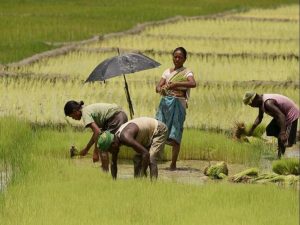Kharif Strategy 2021:

The Ministry of Agriculture & Farmers Welfare has formulated Kharif Strategy 2021 to achieve self-sufficiency in edible oils.
Kharif Season:
- Crops are sown from June to July and Harvesting is done in between September-October.
- Crops are: Rice, maize, jowar, bajra, tur, moong, urad, cotton, jute, groundnut, soyabean etc.
- States are: Assam, West Bengal, coastal regions of Odisha, Andhra Pradesh, Telangana, Tamil Nadu, Kerala, and Maharashtra.
About the Kharif Strategy 2021:
- An ambitious plan for the free distribution of high-yielding varieties of seeds to the farmers for the Kharif season 2021 in the form of mini-kits.
- Strategy for both area and productivity enhancement has been formulated for soybean and groundnut under the National Food Security Mission (Oil Seeds and Oil Palm).
- It will bring an additional 6.37 lakh hectare area under oilseeds and is likely to produce 120.26 lakh quintals of oilseeds and edible oil amounting to 24.36 lakh quintals.
- Oilseed crops are the second most important determinant of the agricultural economy, next only to cereals within the segment of field crops.
- The self-sufficiency in oilseeds attained through the “Yellow Revolution” during the early 1990s, could not be sustained beyond a short period.
- Oilseed crops are primarily grown for the purpose of obtaining vegetable oils from them. Oil content in them varies from 20% in soybeans to 40% in sunflowers and canola (rapeseed).
- India is able to produce a huge amount of oilseeds because of the favorable environmental conditions.
- Castor seed, sesamum, rapeseed, groundnut, mustard, soybean, linseed, niger seed, sunflower, and safflower are some of the important oilseeds India is known to produce.




